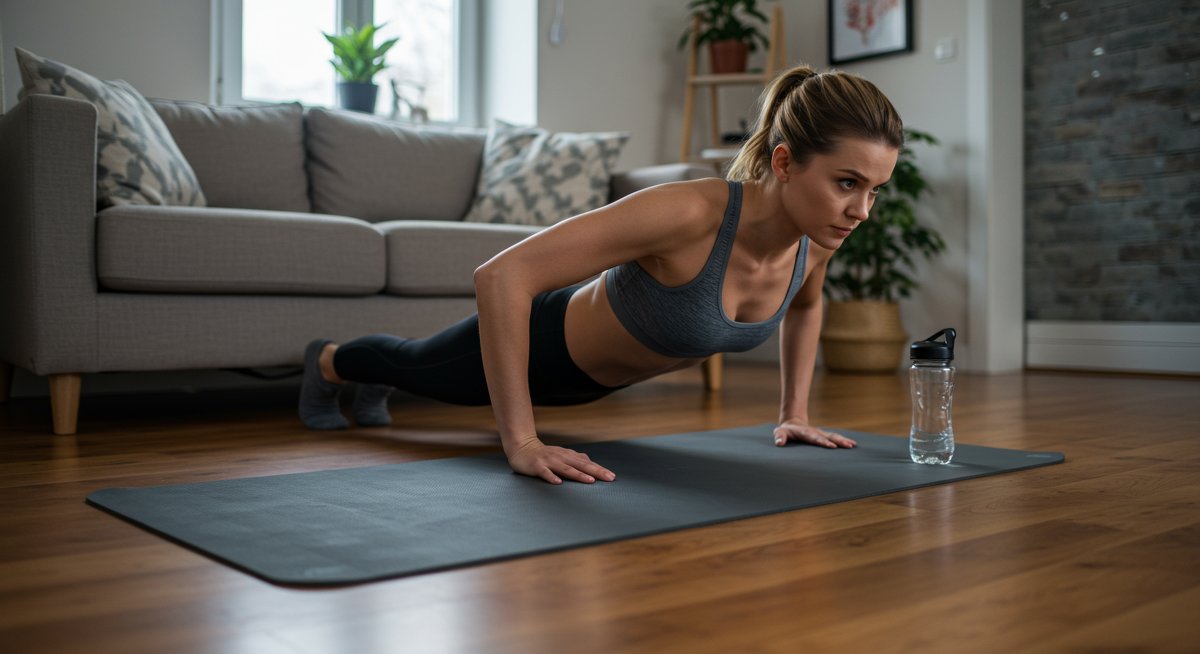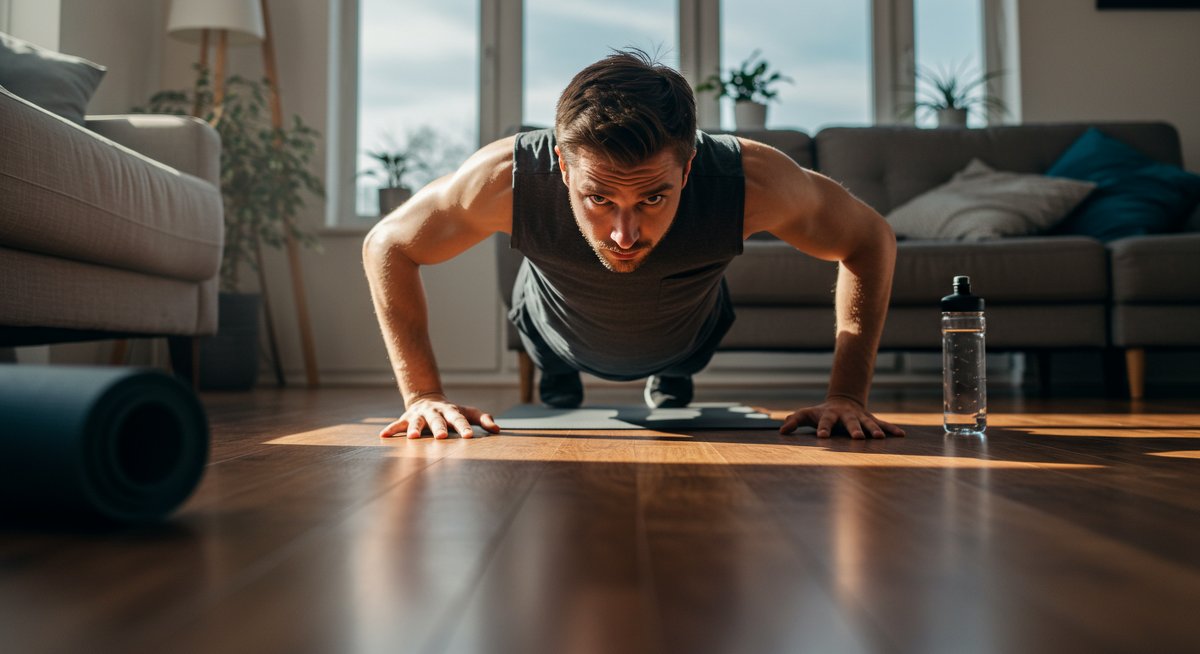Are you ready to sculpt a stronger upper body from the comfort of your home? This guide is designed specifically for beginners, providing you with five effective bodyweight exercises that require no equipment. Whether you're short on time or just starting your fitness journey, these exercises are simple to follow, easy to modify, and perfect for building strength. Let's get started on your path to a more powerful upper body!

Why this workout is perfect for home beginners
This workout is ideal for beginners for several reasons. First, it requires absolutely no equipment, making it accessible to anyone, anywhere. You don't need to invest in expensive weights or machines. Second, it's designed to be time-efficient. You can complete the entire routine in about 20 minutes. Third, the exercises are fundamental movements that build a solid foundation of strength. You'll learn proper form, which is crucial for preventing injuries and maximizing results. Fourth, it's adaptable. You can modify the exercises to suit your fitness level, whether you're just starting out or have some prior experience. Finally, doing this workout at home removes the intimidation of a crowded gym. You can work out at your own pace, in a comfortable environment.
For example, if you're a busy professional who struggles to find time for exercise, this home workout allows you to squeeze in a quick session before work or during a lunch break. Or consider someone who has limited mobility or is recovering from an injury. The exercises can be modified to be gentler on the joints while still providing a good workout. Lastly, consider someone who lives in a small apartment. This routine takes up minimal space, and you can do it without disturbing your neighbors.
Essential moves you'll need
Before diving into the workout, let's cover the essential moves. Proper form is key to getting the most out of your workout and preventing injuries. We'll break down each exercise step-by-step, with tips to ensure you're doing them correctly. Remember to focus on controlled movements and engaging the correct muscles. If you are new to working out, consult with your doctor before beginning this or any exercise program.
Push-ups: A classic exercise that works your chest, shoulders, and triceps. You can modify them by doing them on your knees if standard push-ups are too difficult.
Incline Push-ups: This variation puts less stress on your shoulders while still engaging the same muscle groups.
Tricep Dips: Work your triceps using a chair or any stable elevated surface.
Plank: A great exercise to strengthen your core. Your core is the foundation for all upper body exercises, so a strong core is important.
Superman: This exercise helps improve the muscles in your back, contributing to better posture and overall upper-body strength.
Step-by-step instructions
Here's a detailed breakdown of each exercise, including step-by-step instructions and modifications for beginners:
Push-ups:
- Step 1: Start in a plank position with your hands shoulder-width apart, fingers pointing forward.
- Step 2: Lower your body until your chest nearly touches the floor, keeping your back straight.
- Step 3: Push back up to the starting position, extending your arms fully.
- Step 4: Repeat for 3 sets of as many reps as possible (AMRAP) with good form.
- Beginner Modification: Perform push-ups on your knees to reduce the difficulty. Keep your back straight.
Example: Sarah, a beginner, found standard push-ups too challenging. By doing them on her knees, she was able to perform 3 sets of 10 reps, gradually building strength and confidence. This small adjustment made a huge difference in her ability to complete the workout.
Incline Push-ups:
- Step 1: Place your hands on an elevated surface, such as a wall or a sturdy chair, shoulder-width apart.
- Step 2: Lean forward, keeping your body in a straight line from head to heels.
- Step 3: Lower your chest towards the surface, bending your elbows.
- Step 4: Push back up to the starting position.
- Step 5: Repeat for 3 sets of 10-15 reps.
- Beginner Modification: Use a higher surface to make the exercise easier.
Example: John, a beginner with a history of shoulder issues, found that incline push-ups allowed him to work his chest and triceps without putting too much stress on his shoulders. He started with a wall and gradually progressed to using a lower surface as his strength improved.
Tricep Dips:
- Step 1: Sit on the edge of a chair with your hands gripping the edge, fingers pointing forward.
- Step 2: Slide your butt off the chair, keeping your legs extended or knees bent.
- Step 3: Lower your body by bending your elbows to about a 90-degree angle.
- Step 4: Push back up to the starting position, extending your arms.
- Step 5: Repeat for 3 sets of 10-15 reps.
- Beginner Modification: Bend your knees to make the exercise easier.
Example: Emily, a beginner, initially found tricep dips challenging. To make the exercise easier, she bent her knees and kept her feet flat on the floor. This allowed her to focus on the movement and build the necessary strength in her triceps.
Plank:
- Step 1: Start in a push-up position, but with your forearms on the ground instead of your hands. Your elbows should be directly under your shoulders.
- Step 2: Keep your body in a straight line from head to heels. Engage your core.
- Step 3: Hold this position for as long as you can maintain good form. Aim for 3 sets, holding for 30-60 seconds.
- Beginner Modification: Start with shorter holds (e.g., 15-20 seconds) and gradually increase the duration.
Example: David, a beginner, started with 20-second planks and gradually increased the hold time over a few weeks. The plank helped him improve his core strength, which then translated to better form in his other upper-body exercises.
Superman:
- Step 1: Lie face down on the floor with your arms and legs extended.
- Step 2: Simultaneously lift your arms, chest, and legs off the floor, engaging your back muscles.
- Step 3: Hold for a few seconds.
- Step 4: Slowly lower back down.
- Step 5: Repeat for 3 sets of 10-15 reps.
- Beginner Modification: Focus on lifting a little higher each time, but don't strain your back.
Example: Maria, a beginner, found the superman exercise helped alleviate back pain from sitting at a desk all day. She started with just a few reps and gradually increased the number as her back muscles grew stronger.
Tips for success
To maximize your results and avoid common mistakes, keep these tips in mind:
- Warm-up: Before each workout, do a light warm-up, such as arm circles, shoulder rolls, and a few minutes of cardio, like jumping jacks.
- Proper Form: Always prioritize proper form over the number of repetitions. Poor form can lead to injuries.
- Listen to Your Body: Don't push yourself too hard, especially when you're just starting. Rest when you need to.
- Consistency is Key: Aim to do this workout 2-3 times per week for best results.
- Cool-down: After your workout, cool down with some static stretches, holding each stretch for 30 seconds.
Common Mistakes to Avoid:
- Rushing Through Exercises: Focus on controlled movements rather than speed.
- Not Engaging Your Core: Keep your core tight throughout the exercises to protect your lower back.
- Poor Posture: Maintain good posture to avoid injuries.
Expert Tip: To make your workouts more effective, consider incorporating progressive overload. This means gradually increasing the intensity of your workouts over time. You can do this by adding more reps, sets, or holding the exercises for a longer duration. For example, if you are doing push-ups, you could gradually increase the number of reps you do in each set each week.
Benefits and how it helps your goals
This bodyweight workout offers numerous benefits for beginners:
- Increased Strength: Regularly performing these exercises will build muscle strength in your chest, shoulders, triceps, and back.
- Improved Posture: Strengthening your back muscles with exercises like the Superman can help improve your posture.
- Enhanced Fitness: Regular exercise boosts your overall fitness level, making everyday activities easier.
- Weight Management: Building muscle can increase your metabolism, which can aid in weight management.
- Convenience and Accessibility: You can do this workout anytime, anywhere, without needing any special equipment or a gym membership.
How to fit it into your busy schedule
One of the best things about this workout is its flexibility. Here are some tips for incorporating it into your busy schedule:
- Morning Workout: Wake up 20 minutes earlier and get your workout done before the day begins.
- Lunch Break: Use your lunch break to squeeze in a quick session.
- Evening Routine: Incorporate the workout into your evening routine, before or after dinner.
- Weekend Warriors: If you have more free time on weekends, do the workout then.
Quick warm-up and cool-down
Quick Warm-up (5 minutes):
- Jumping jacks (1 minute)
- Arm circles (forward and backward) (1 minute)
- Shoulder rolls (1 minute)
- Dynamic stretching: arm swings, torso twists, leg swings (2 minutes)
Quick Cool-down (5 minutes):
- Chest stretch: Stand with your hands clasped behind your back and gently lift your arms. (30 seconds)
- Triceps stretch: Reach one arm overhead and bend your elbow, dropping your hand behind your head. Gently pull your elbow with your other hand. (30 seconds per side)
- Shoulder stretch: Cross one arm across your body and hold it with your other hand. (30 seconds per side)
- Child’s Pose: Kneel on the floor, sit back on your heels, and fold forward, resting your forehead on the floor. (1 minute)

Next steps in your home fitness journey
Congratulations on completing this beginner upper body workout! Here are some next steps to continue your home fitness journey:
- Progressive Overload: Gradually increase the difficulty of your workouts by adding more reps, sets, or trying more advanced variations of the exercises.
- Explore Other Bodyweight Exercises: Incorporate other exercises, such as squats, lunges, and planks, to work other muscle groups.
- Find a Fitness App: To help track your progress, consider using a fitness app like the Nike Training Club App. This app provides guided workouts, workout programs, and helpful information to keep you motivated.
- Stay Consistent: The most important thing is to stay consistent with your workouts. Aim to exercise at least 2-3 times a week.
- Listen to Your Body: Rest when you need to, and don’t be afraid to modify exercises if needed.
- Nutrition: Pair your workouts with a balanced diet to optimize your results.